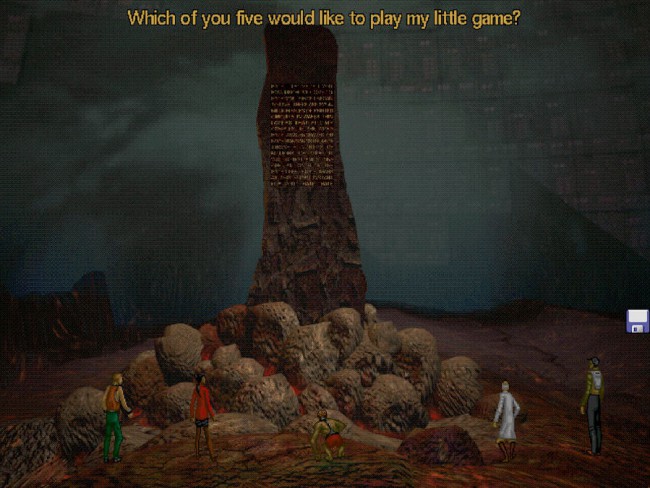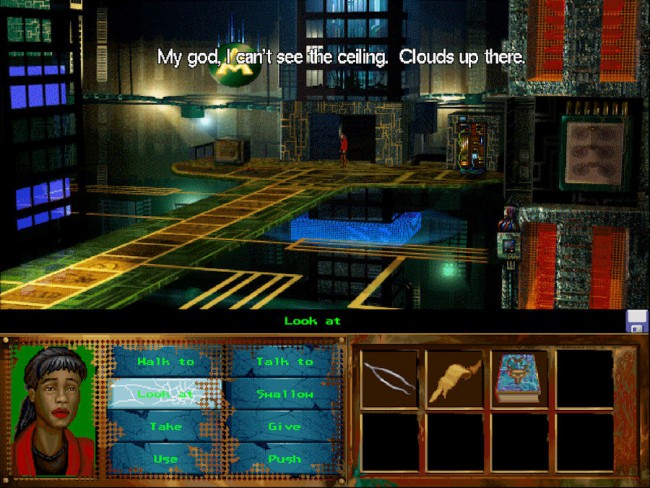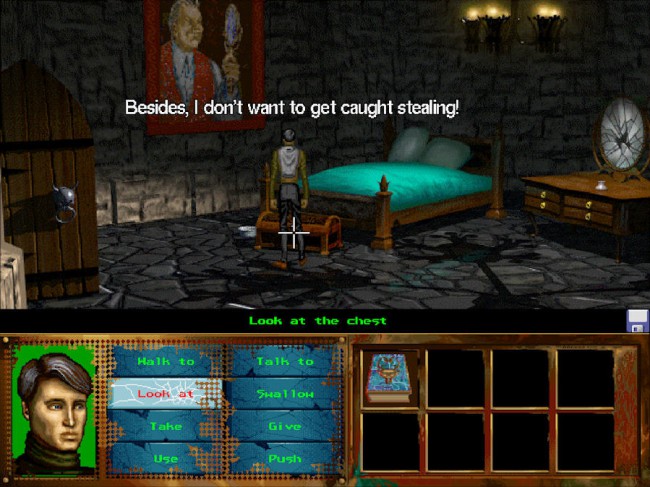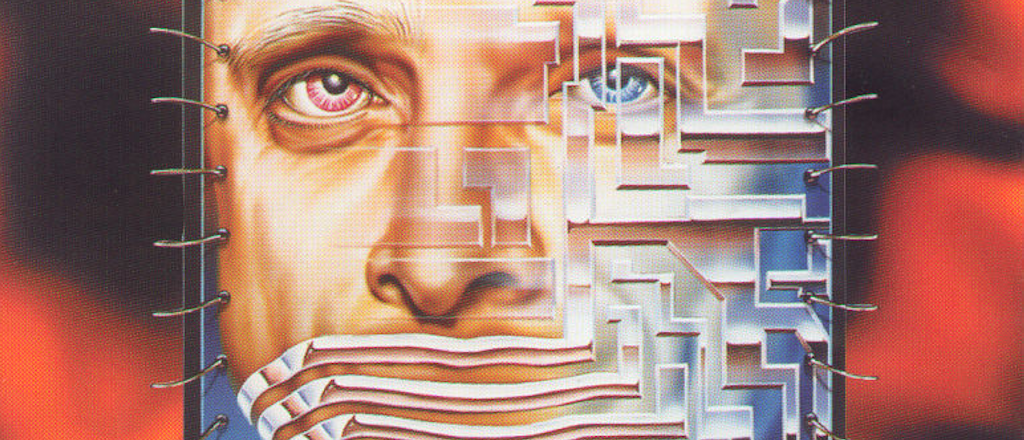Developer: The Dreamers Guild | Released: 1995 | Genre: Adventure, Point & Click
I Have No Mouth, and I Must Scream is a point-and-click adventure game based upon Harlan Ellison’s short story of the same title, developed by The Dreamers Guild, co-designed by Ellison and published by Cyberdreams in 1995. The game’s story is set in a world where an evil computer named AM has destroyed all of humanity except for five people, whom he has been keeping alive and torturing for the past 109 years. Each survivor has a fatal flaw in its character, and in an attempt to crush their spirits, AM has constructed a metaphorical adventure for each that preys upon their weaknesses. To succeed in the game, the player must make choices to prove that humans are better than machines, because they have the ability to redeem themselves. Woven into the fabric of the story are ethical dilemmas dealing with issues such as insanity, rape, paranoia and genocide.Wikipedia
I started this game after a recommendation on Extra Credits. I have completed my fair share of adventure games and are quite picky about them these days (I thought the new Broken Sword 5 was downright boring) but I must confess that this classic has some quite interesting adult themes to spice things up. The dialog is well written and it doesn’t hold back from putting you through dark and disturbing issues. There are lots of tasks that are optional or branch out into two or more solutions, and they are of course often based on a moral choice. But even though the game has wonderfully bizarre backgrounds and quite logical puzzles, it still bored me a little in the end. This is very much an adventure game of its time, in spite of the adult theme and the interesting dialog. It’s very possible to get into the dreaded trial-and-error loop where you try inventory items on everything and scrutinize the screen for overlooked hotspots.

The interface closely resembles that of the LucasArts adventure games. You have your basic walk, talk and use buttons, you can talk to people with dialog choices, and you have a small inventory. The five characters, Gorrister, Ellen, Benny, Nimdok and Ted, are freely available in the beginning. At first I thought it was kind of like an RPG and you could choose one to go through the entire game with, but it turns out that you have to play all of them. I started from right to left with Ted, just to be contrarian, but it doesn’t really matter what order you choose to play their individual episodes.
The gameplay seems to focus a lot on the aforementioned moral dilemmas and the choices to make. A few of these choices were obscure enough for me to make silly mistakes that I regret much later. For example, at one point I took a jar with something awful in it that I thought didn’t make a difference just having around in my inventory. However, much later someone actually saw that I was carrying this jar around and it seemed to affect the outcome of the scene considerably. But most of the choices actually have immediate consequences, typically by affecting the moral meter of your avatar for better or for worse. This made it damn tempting to just save scum my way through the episodes, reloading a save game whenever I took the wrong moral hit.
For most of the characters, the individual character simulations are not overwhelming. Typically about eight screens, and in some cases the later screens are even blocked until you get to a certain story point. Gorrister seems to have the odd one out with more screens and a generally longer episode, and it was also the only one I was really stuck in. Hotspots are often relatively few and not too hard to figure out, but since the game is from the 90’s, it doesn’t hold your hand and phone them in. You have to find them yourself with your mouse pointer. Another thing to get used to is that some hotspots or characters won’t show up until you have said or done a specific thing to trigger it. This can quickly inflate being stuck, as a small change or piece of dialog may mean having to go through a lot of hotspots all over again. Another downside is the exits and passages. A lot of them are located at the edge of the screen and are invisible, forcing you to meticulously search for them with the mouse pointer.

The graphics seems to be static screens in Super-VGA and was probably quite nice in 1995. Music sounds like MIDI and honestly a bit too busy for my liking, like it’s trying too hard. Animations are borderline hilariously twitchy. I heard about actual gameplay bugs, but the few I saw were just visual, like an invisible object or character, or my character walking backwards to a hotspot. All dialog have voice overs, and they are quite all right. AM itself is even voiced by the original writer, Harlan Ellison. Whenever a good deed or an important discovery is made, a small jingle plays and the avatar face is happy for a moment. One thing I didn’t catch until much later was that the background color behind the avatar shows how much you’ve redeemed yourself. Brighter green is better. A permanent part of everyone’s inventory is a Psych Profile book with randomly changing text that can give your character a few scares.
Minutia
Here I’m going into details with sometimes biased observations. This may be spoiler ridden. Whether you want to complete the game first or don’t give a hoot is up to you.
Last warning. There will be spoilers here.
- As Ted, I could enter a castle with five monitors and quickly found out that touching the wrong ones immediately killed me. Strangely, the subsequent characters didn’t have to go through this monitor selection process. They just immediately showed up in their appropriate simulation.
- Ted’s simulation was about walking around inside a castle, searching for a mirror for his beloved Ellen. Ellen lies weak in a bed on the brink of death, and during the quest for the mirror you have to decide whether to offer her soul to a demon, the devil, or an angel. I have read somewhere that this is not the same Ellen as the playable one. Then why give her the same name? Sheesh!
- Tips were available in books in two libraries, and I could sleep with a maid for help. Here I decided to reload and fix her oven instead. I just couldn’t get myself to cheat on Ellen like that.
- Nimdok looked more like a zombie than an old scientist. Also very cute the way the swastika was replaced by the AM logo, yet everything else in the story made it abundantly clear this was indeed Nazi-Germany in 1945.
- There were quite a few grim scenarios here not for the faint of heart. I skipped the operations and explored instead. Never managed to awake the golem, though – I wonder if that was possible?
- I loved the way Benny tried to walk up the stairs then came tumbling down. Sorry, I probably ought to be ashamed of myself, but I just thought it looked damn funny.
- Benny had to make a doll out of various components for a kid. The components were not hard to find, but it was a good example of hotspots that only appeared when I had a use for them.
- It seems that all character simulations inevitably ends in a cage, no matter how much you’ve redeemed yourself. AM doesn’t play nice. I guess he must be related to HAL-9000.
- And what’s up with the red text on a red background for the selected dialog choice? I often had to deselect and select again to be sure I had the right one.
- So, Ellen didn’t like the color yellow, eh? See the Green Lantern for excellent boyfriend material.
- To bypass the color yellow Ellen had to wear a blindfold. I was thinking, why not color filters instead? Mixing or adding colors to produce other kinds of colors could have made for a great puzzle.
- Bug: When Ellen took off the blindfold she still acted as if she was wearing it. Repeating the action fixed it, though.
- Sometimes, when Ellen was excited and yelling something, she actually sounded a little bit like Sandra Bullock. That’s a big plus in my book, by the way. Sandra Bullock is awesome.
- Gorrister had much more inventory overload in his episode than any of the others. His episode also felt much longer. Maybe they made it this way because he’s the first character from the left and thus the most logical character to start with? You know, first impressions.
- I somehow like how consistently bad luck Gorrister’s elephant gun turned out to be. It appears to be useful for one particular spot in the end of his episode, and if you dare try it anywhere else, it blows up the entire simulation along with you in it. Potent gun indeed.
- Bugs: After Gorrister dug the grave hole it later disappeared, but it still worked for burying a body. Gorrister himself also went invisible a couple of times after loading a save game.
- Two ways to get Gorrister a heart for the jackal exchange – either cut out a heart from pig meat or kill Harry. Needless to say, the latter was a bad act and also made me feel too much like Hannibal Lecter.
- The reason I was stuck in Gorrister’s episode, which even made me peek once in a walkthrough, was getting the rope back by cutting it off the ring. Didn’t think to get the rope and tie up Edna with it. The puzzle is logical though, so I can’t blame the game. My bad.
- After the five character episodes there’s an extra sequence which I’ll name the aftermath. I chose Ted to begin with and soon got into a series of zapping and killing and reloading and shutting power off on pillars. Only when I tried Nimdok did I feel like having the upper hand.
- Nice touch with a sound effect for most of the inventory items in the aftermath. Saved on having to record description lines, I guess. Also, I could go crazy and make my own little percussion song.
- Ah, so raising the avatar background color with good deeds was brought into the aftermath? Cool idea. Sort of defined the health levels for pillar and skull zapping. Zapping drained from white to dark green, then finally death.
- And about death. It seemed to be final, so I guess that meant it was very possible to muck it up in a way so that the game couldn’t be solved. That being said, I got the good ending with one pillar still being powered up, so there you go.
- I didn’t really like the amount of inventory trial-and-error craziness in the aftermath. Especially prior to trying Nimdok. Also a bit too much excessive use of zapping for my taste.
- The summoned demon named the other AI guys “loser one and loser two” – he he. I liked this demon. A shame I had to waste him.
- It wasn’t really until this aftermath that I really got irritated by the fact that the game didn’t offer any quick exit functionality (e.g. double-click) that I could find anyway. Lots of walking as a small character in a big brainy maze landscape.
- Bug: At one point I had Ted walking around on the Psych Profile book page. It was only a visibility bug. I just had to find one of the invisible exits (my favorite) and the screen returned to normal.
- Any particular reason why neither the end credits nor the PDF manual lists the actors used, apart from Ellison as AM? Oh well; IMDb is your friend.
You can open your eyes again now. The abominable spoiler panda has left the building.

I just don’t have the patience for this type of adventure game anymore. I have been spoiled by the greater freedom in controlling an avatar in a 3D world, and the trial-and-error inventory combining business always drive me nuts. This kind of archaic game design have had its time. I’m not going to say never again, but it has to be really special for me to plunge into another one of these.
| TitleLength | Dates | Diff / Cht | Save | Score | |
|---|---|---|---|---|---|
|
I Have No Mouth, and I Must Scream
1995 The Dreamers Guild9h 12m 6
|
2015-07-05 2015-07-26 |
7
|


